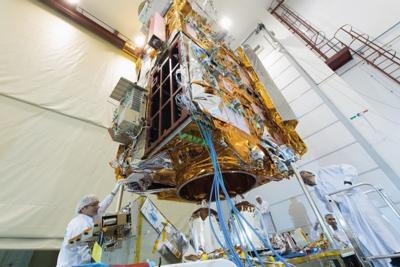Mon, Aug 21, 2017
The Third And Final Satellite Of The First Generation Of MetOp Polar-Orbiting Meteorological Satellites
The payload module of MetOp-C, developed and built by Airbus in Germany, was delivered to Toulouse after it completed a series of tests at ESTEC, the technical center of the European Space Agency (ESA) in Noordwijk, the Netherlands. The satellite, weighing in at four tonnes, is now almost complete after successful coupling of its payload and service module. In preparation for the launch scheduled for October 2018 from Kourou, French Guiana, MetOp-C will undergo a further series of radio-electric tests in the coming weeks. The solar panel, which is the last outstanding major component, will be integrated in November 2017 just before vibration testing.

The MetOp satellites have been developed by Airbus for ESA and EUMETSAT, the European Organisation for the Exploitation of Meteorological Satellites, and are part of a joint European-US cooperation. EUMETSAT is responsible for operating the satellites. MetOp-A, the first satellite in the series, was launched in October 2006 and has since doubled its specified five-year service life. MetOp-B was launched into orbit in 2012 and is also about to exceed its design service life. Initially, the plan was that each satellite would replace its predecessor, however, the excellent performance of the first two MetOp satellites means that they can now be operated simultaneously, providing the meteorological community with increased data. The forthcoming launch of MetOp-C will further improve the quality of observations and data provided for weather forecasts.
Each MetOp satellite carries a total of 12 instruments, making the system extremely versatile. The microwave humidity sounder, built by Airbus, delivers data on water vapour near the Earth’s surface and is part of the collaboration with the US. As well as each MetOp satellite carrying the instrument, two more are flying on US NOAA satellites, delivering matching data from a different orbit to enhance weather models. MetOp also measures ocean surface winds, observes sea ice distribution and monitors the ozone layer in the stratosphere, as well as relaying meteorological measurements collected by boats, buoys and research stations. It also includes a receiver to relay signals sent by persons in distress.
MetOp has enhanced the accuracy of weather forecasting and allowed extending the short-term forecasts by one day.
(Image provided with Airbus news release)
More News
Aero Linx: Model Aeronautical Association of Australia MAAA clubs are about fun flying, camaraderie and community. For over 75 years, the MAAA has been Australia’s largest fl>[...]
Touchdown Zone Lighting Two rows of transverse light bars located symmetrically about the runway centerline normally at 100 foot intervals. The basic system extends 3,000 feet alon>[...]
“Discovery and innovation are central to our mission at Virgin Galactic. We’re excited to build on our successful record of facilitating scientific experiments in subor>[...]
How To Get A Story On Aero-TV News/Feature Programming How do I submit a story idea or lead to Aero-TV? If you would like to submit a story idea or lead, please contact Jim Campbel>[...]
Student Pilot Reported That During Rotation, “All Of A Sudden The Back Of The Plane Kicked To The Right..." Analysis: The student pilot reported that during rotation, “>[...]
 ANN's Daily Aero-Linx (05.02.24)
ANN's Daily Aero-Linx (05.02.24) ANN's Daily Aero-Term (05.02.24): Touchdown Zone Lighting
ANN's Daily Aero-Term (05.02.24): Touchdown Zone Lighting Aero-News: Quote of the Day (05.02.24)
Aero-News: Quote of the Day (05.02.24) ANN FAQ: Contributing To Aero-TV
ANN FAQ: Contributing To Aero-TV NTSB Final Report: Cirrus Design Corp SR20
NTSB Final Report: Cirrus Design Corp SR20



